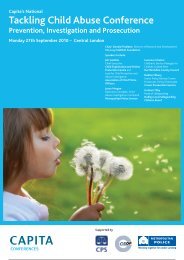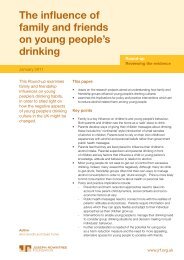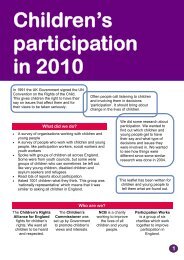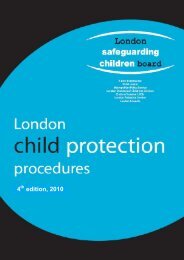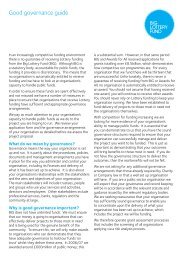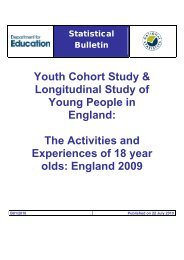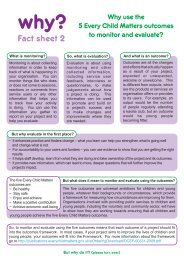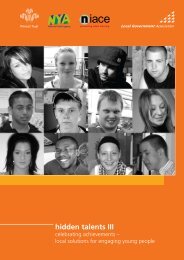Transforming Youth Work Resourcing Excellent Youth Services
Transforming Youth Work Resourcing Excellent Youth Services
Transforming Youth Work Resourcing Excellent Youth Services
- No tags were found...
You also want an ePaper? Increase the reach of your titles
YUMPU automatically turns print PDFs into web optimized ePapers that Google loves.
<strong>Transforming</strong> <strong>Youth</strong> <strong>Work</strong><strong>Resourcing</strong> <strong>Excellent</strong> <strong>Youth</strong> <strong>Services</strong>
ContentsContents 1Foreword 3Section 1 Introduction 4Section 2 The <strong>Youth</strong> Service 6Section 3 What the Government Expects of a Local Authority 8Section 4 What Should be Provided Locally 10Pledge to Young People 10Mainstreaming Equal Opportunities and Diversity 10A Curriculum for <strong>Youth</strong> <strong>Work</strong> 11Standards of <strong>Youth</strong> <strong>Work</strong> Provision 11Health and Safety and the Protection of Young People 12Contributing to Connexions 12<strong>Work</strong>ing with the Voluntary and Community Sector 13Section 5 <strong>Resourcing</strong> a Sufficient <strong>Youth</strong> Service 14Government Investment 14Other Resources 15Section 6 Measuring Performance 16<strong>Youth</strong> Service Performance Measures 16Assuring Quality 17Monitoring Performance 18Annex 1 <strong>Youth</strong> <strong>Work</strong> Values 20Annex 2 Statutory Functions of Local Authorities and the Secretary of State 21Annex 3 Local Authority Pledge to Young People 22Annex 4 Standards of <strong>Youth</strong> <strong>Work</strong> Provision 23Annex 5 Framework for a <strong>Youth</strong> <strong>Work</strong> Curriculum 27Annex 6 The Inspection Process 28Annex 7 <strong>Work</strong>force Development 31Annex 8 <strong>Youth</strong> and Community <strong>Services</strong> Definitions 341
2We have provided funding for 450 places onthe first ever national management trainingprogramme for senior youth service managersin the voluntary and statutory sectors.
ForewordThis is a landmark document. For the first time it sets out the Government’s specificationfor an ‘<strong>Excellent</strong> <strong>Youth</strong> Service’. I am delighted to present it in partnership with the LocalGovernment Association (LGA).In publishing <strong>Transforming</strong> <strong>Youth</strong> <strong>Work</strong> – developing youth services for young peoplelast year the Government signalled a new beginning for youth work in England. We outlinedthen our vision for youth work set in the context of the Connexions Service and our policiesto ensure that every young person participates fully in society and the economy. The youthservice has the experience and potential to make a lasting difference to young people asthey make the transition from adolescence to adulthood.We know only too well the consequences of young people becoming disaffected fromtheir communities – the sense of worthlessness and the drift into anti-social behaviourand crime which can result. The Government is determined to achieve social justice andeconomic success for all our citizens. The youth service is well placed to support youngpeople in understanding their rights and responsibilities and to develop as active citizensand participants in our democratic processes.We have listened to what you told us in response to our consultation and embarked uponan ambitious development programme. We want to secure a modernised youth servicewhich delivers a consistently high standard of youth work. We have injected additionalresources to make that happen. And with that fresh investment we expect to see reform –reform in the way in which the service is developed, delivered and managed. We issuedplanning guidance in September 2002 providing a common planning framework,supported by training to help local authorities prepare their youth service plans for 2003 –04 to deliver that modernised service.I am very grateful for the commitment of the youth service and its key partners, includingLGA, National <strong>Youth</strong> Agency (NYA), Association of Principal <strong>Youth</strong> and Community Officers(APYCO) and National Council for Voluntary <strong>Youth</strong> <strong>Services</strong> (NCVYS), to work towards thisshared vision. There is evidence already of first-rate practice – the task now is to develop anexcellent and responsive service for all young people, wherever they live and whatever theircircumstances, and which challenges them to develop and engage in their communities.This document provides the foundation for sustained progress. I know that you want towork with us to build a youth service fit for the 21st Century.Charles ClarkeSecretary of State for Education and Skills3
Section 1INTRODUCTIONThis document provides a specification of a sufficient local authority youth service. It sets outwhat the Government expects a local authority to provide through its strategic leadershiprole. It provides direction regarding:• the local authority’s duty to provide a youth service;• the Secretary of State’s powers of intervention and direction;• a youth service plan agreed by members following consultation with partners;• the contribution the youth service makes to other Government priorities such astackling anti-social behaviour and crime;• a local pledge to young people;• national standards of provision;• health and safety requirements;• mainstreaming equal opportunities, diversity and community cohesion;• support and investment to voluntary and community based youth work;• the youth work curriculum;• targeted provision;• local authority planning and delivery of substantial increases in the resource andactivity levels of their youth services; and• clearly designed quality assurance processes.4
The specification underpins the <strong>Transforming</strong> <strong>Youth</strong> <strong>Work</strong> modernisation programme andthe Government’s commitment to work with local authorities to ensure the delivery of ahigh quality youth service for our young people, which is at the heart of the ConnexionsService. This specification should be read alongside the Planning for Local Authority <strong>Youth</strong><strong>Services</strong> 2003 – 04 Guidance document and the <strong>Work</strong>ing Together – Connexions Serviceand the Statutory <strong>Youth</strong> Service guidance which was endorsed by the National <strong>Youth</strong>Agency (NYA), Local Government Association (LGA) and Association of Principal <strong>Youth</strong> andCommunity Officers (APYCO). The latter clearly outlines the role of the youth service andyouth worker as key partners in the Connexions Service and in contributing to cross cuttingpreventive strategies including identification, referral and tracking of young people.The Department for Education and Skills (DfES) has worked closely with other GovernmentDepartments (OGDs) and a range of partners in finalising this document, including the LGA,NYA, APYCO, National Council for Voluntary <strong>Youth</strong> <strong>Services</strong> (NCVYS), trade unions, thevoluntary and community sector and the wider youth work field.This specification will provide the essential foundation to complement Ofsted’s InspectionFramework for <strong>Youth</strong> <strong>Work</strong> and companion Self Assessment Schedule. Ofsted inspect andreport on youth work and Government Offices (GOs) provide a local function in assessingprogress against the Action Plans which the Secretary of State now requests from the localauthority following publication of the inspection report.5
Section 2THE YOUTH SERVICEAs they grow up young people are helpedby their families and their friends. Schoolsand other services, including Connexions,encourage their development and offerfacilities for learning, enjoyment, welfare orsupport. Only the youth service has as itsprimary purpose the personal and socialdevelopment of young people.The youth service is a complex network ofproviders, community groups, voluntaryorganisations and local authorities. The latterplay an important role in harnessing theendeavours of partners, in facilitating access tohousing or leisure facilities and in assisting theachievement of important shared targets incommunity order and safety, health, citizenship,education, training and employment.The vital diversity of “youth services” isunderpinned by having in place a shared setof youth work values (see Annex 1) and bythe use of distinctive methods, for exampleeducational group work, which seek topromote learning and achievement throughrelationships with adults which have beenfreely chosen by young people themselves.A statement of ethical conduct sets outprinciples for practice in youth work 1 .This particular combination of goals,methods and values characterises youthwork. It occurs in different contexts, forexample in neighbourhood centres, schools,college sites, detached or outreach work orspecialist projects which may use the arts oradventurous activities as vehicles for learning.Annex 8 provides definitions of <strong>Youth</strong> andCommunity <strong>Services</strong> which support financialplanning and accounting.61 See Statement of Ethical Conduct, National <strong>Youth</strong> Agency.
Section 3WHAT THE GOVERNMENT EXPECTS OF A LOCALAUTHORITYA local authority has a duty to ensure the provision of a sufficient youth service(see Annex 2).The Government expects local authorities, in partnership with voluntary bodies and others,for example not for profit and private sector organisations, to demonstrate strategicleadership and to have a clear understanding of the local circumstances which impact uponthe lives of young people. Local authorities will, with the co-operation of their partners,carefully identify, assess and analyse the nature of the needs of young people throughouttheir area. They will also be able to demonstrate how resources have been strategicallyallocated to address those needs, and have a clear grasp of any particularly challengingcircumstances which need priority attention. In so doing they should ensure that the youthservice has a management and leadership capacity able to represent the whole youth serviceat a strategic, partnership and delivery level. It should have the capacity and flexibility towork with local partners within the local authority, and others such as the police on key localand national priorities and tackling anti-social behaviour. It should promote the social, moral,cultural, emotional and physical development of young people, involve young people in thegovernance of relevant services and encourage young people’s preparation for theresponsibilities, opportunities and expectations of adulthood and citizenship.8
• Review local, utility, state, and federal energy incentives available to yourcustomer• The Database of State Incentives for Renewables & Efficiency – the mostcomprehensive source of information on federal, state, local, and utilityincentives and policies that promote renewable energy and energyefficiency• The Tax Incentives Assistance Project (TIAP) – provides guidance forhomeowners and businesses to take advantage of the Energy Policy Act2005 (EPAct), subsequent laws and federal tax incentives• The local electric utility may have other incentive programs. Be sure tounderstand all the details and paperwork requirements• Offer to assist customer with the paperwork11
A Curriculum For <strong>Youth</strong> <strong>Work</strong>Each local authority youth service should have a clear curriculum statement. <strong>Youth</strong> work offersparticular ways of learning, characterised by processes which encourage personal and socialdevelopment and reflect wider social issues. Young people can develop the skills and knowledgeneeded for their longer-term employability, including basic skills in literacy and numeracy, and anincreased awareness of health and social issues such as drugs and alcohol education.The broad curriculum goals should include helping young people to explore the issues whichaffect them; to make responsible choices; to encourage social interaction and compassion; topromote self-acceptance through offering positive feedback; and to act on their understanding.There should be an emphasis on promoting active citizenship and engagement withdemocratic and political processes. As part of this young people will gain a clearerunderstanding of their rights and responsibilities.The goals for informal education through youth work complement those of more formalroutes such as schools and colleges.Such broad goals need to be expressed in a set of more specific outcomes if they are to behelpful in planning and in practice. The more clearly we can specify the ends, the better wewill be able to choose the means for achieving them. Annex 5 sets out more detail on aframework for a youth work curriculum.Standards of <strong>Youth</strong> <strong>Work</strong> ProvisionLocal authorities should ensure the delivery of a service which:• targets the 13–19 age range but may also be working at the margins with11–13 and 19–25 year olds 2 ;• aims to reach 25% of the target age range in any given year of operation (and similarproportions for different ethnic groups);• maintains a balanced range of provision delivered through a variety of outlets;• deploys appropriately trained and qualified staff;• has sufficient resource to invest in provision including Information and CommunicationTechnology (ICT) and to provide capital investment in existing and future buildingstock;• has a sufficient balance of well trained managers to qualified youth workers;• has a capacity to respond to new demands and needs of young people;• has a continuous professional development programme for all staff, voluntary or paid;and• has a clearly defined quality assurance process.2 <strong>Work</strong>ing Together encouraged local authorities to concentrate not less than 80% of the available youthwork resource on 13–19 year olds by 2003.11
Section 5RESOURCING A SUFFICIENT YOUTH SERVICELocal authority youth service budgets are decided locally. One result of this is the enormouslydifferentiated level of funding across the sector, as described in <strong>Transforming</strong> <strong>Youth</strong> <strong>Work</strong>.Local authority youth service budgets have never been decided using an agreed viewof sufficiency.The Government places great importance on the youth service and its contribution topromoting social inclusion and assisting young people at risk. To emphasise this importance,from 2003–04 onwards, the Government is separately identifying a <strong>Youth</strong> and Communitysub-block within the Education Formula Spending. (This is part of the new structure forlocal government funding being introduced from 2003–04 onwards).A separate <strong>Youth</strong> and Community sub-block will make the potential resource available for<strong>Youth</strong> and Community <strong>Services</strong> clearer. The establishment of this sub-block, linked to adefinition of sufficiency, will allow local authorities to plan for substantial increases in theresource and activity levels of their youth services.Government InvestmentThe Government wants local authorities to deliver substantial improvements to their youthservices. To support this policy the <strong>Youth</strong> and Community sub-block provides potentialresources of £513 million in 2003–04.The sub-block will have its own distribution formula. It allocates the resources to localauthorities using a formula based on numbers of 13–19 year olds and informationrepresenting local needs. The formula allocates a range of values for each local authority,per head of 13–19 population, ranging from £79 to £348. The Government is keen thatwhen local decisions are made about youth service budgets, the resources ensure increasedinvestment in the youth service.The Government is also providing separate grants to support the development of youthservices. It announced £32 million for 2002–04 for the <strong>Transforming</strong> <strong>Youth</strong> <strong>Work</strong>Development Fund (TYWDF), of which £22 million was made available in the first year. £10million will be available for each of the years 2003–04, 2004–05 and 2005–06.• In addition to the TYWDF, £7 million is available for 2002–03 to support local authoritiesto meet their duties under the Special Educational Needs Disability Act 2001. This willincrease to £8 million in each of the years 2003–04, 2004–05 and 2005–06.14
Other ResourcesThe Education Formula Spending and the local authority grants do not provide all theavailable funding for youth work. Many youth services draw on a wide range of alternativefunding sources such as the Learning and Skills Council (LSC), Single Regeneration Budget,European Social Fund, European Regional Development Fund and the Community Fund.In addition, the DfES and OGDs provide specific targeted programmes which involve fundingfor youth work in addition to the Education Formula Spending assessment grant – forexample, Summer Plus, Summer Splash activities and the Neighbourhood Support Fund.However, in order to respond to such initiatives and to access alternative funding streams itis recognised that there needs to be a sustainable core service sufficiently resourcedthrough the Education Formula Spending mechanism. This specification acknowledgesthis and attempts to define the core in both qualitative and quantitative terms.15
Section 6MEASURING PERFORMANCE<strong>Youth</strong> Service Performance Measures<strong>Youth</strong> services contribute to a range of national, cross cutting and locally determined targetsshared by partner agencies operating within the Connexions family of services.The Government has clearly set out the Connexions performance indicators and crosscutting targets which the local authority youth service can partly own or contribute to inthe Planning for Local Authority <strong>Youth</strong> <strong>Services</strong> 2003–04 Guidance. Local authorities willneed to agree locally with Connexions Partnerships how they are targeting youth workresources to contribute to these targets. There may be other cross cutting targets whichthe local authority youth service will need to agree its contribution to locally with otherstakeholders and partners, for example in increasing young people’s access to sport, leisureand cultural activities. However, it is important that we set specific targets for the localauthority youth service so that we can measure improvements in performance. We setout below a set of annual targets and performance indicators.Annual <strong>Youth</strong> ServiceUnique Targets• 25% of the target population13–19 reached (to reflect the culturaldiversity of the community);• Of the 25% reached in the 13–19target population, 60% to undergopersonal and social development whichresults in an accredited outcome;• The target population will include alocally agreed target for thoseassessed as not in education,employment or training (NEET) or whoare at risk of, or who are already fallinto the following categories: teenagepregnancy, drugs, alcohol orsubstance abuse or offending;• 70% of those participating in youthservices expressing satisfactionwith the service.16
<strong>Youth</strong> Service Specific Performance Indicators• spend per head of population in the target age range*/per head of population in thetarget age range priority groups;**• number of personal and social development opportunities/activities offered to youngpeople in the target age range;*• number of personal and social development opportunities offered to young peoplelasting between 10 and 30 hours with a recorded outcome;• number of personal and social development opportunities offered to young peoplelasting from 30 to 60 hours, and leading to an accredited outcome;• number of young people supported who are at risk.* target age range = 13 – 19 year olds** priority groups = those at risk of offending, truanting, pregnancy or taking drugs and / or NEET.Underpinning these measures should be a commitment to conducting regular selfassessment involving young people and an annual user satisfaction survey (see the Pledgeand Standards of Provision).Assuring QualityThe Ofsted Framework for the Inspection of <strong>Youth</strong> <strong>Work</strong> and its companion Self AssessmentSchedule are an important aspect of this specification overview. By themselves, they arevaluable mechanisms which youth services can usefully engage to benchmark the qualityof their day to day operations. Presently the DfES asks Ofsted to inspect up to 15 localauthority youth services in each year. In addition, Ofsted are systematically carrying outre-inspection monitoring visits and full re-inspections in agreement with the DfES andMinisters. Annex 6 outlines the inspection process.Ofsted and youth service managers have reported that putting the Self Assessment Scheduleinto practice prior to a full inspection has proven to be a highly beneficial experience for theservice and local authority. The Planning Guidance 2003–04 and <strong>Transforming</strong> <strong>Youth</strong> <strong>Work</strong>Development Fund 2002–03 guidance both encourage local authority youth services to applythe Self Assessment Schedule as part of their annual evaluation and planning processes.There are also excellent examples of youth services supporting one another through peerreview processes using the Inspection and Self Assessment Schedule to good effect in agood practice context. The National Voluntary <strong>Youth</strong> Organisations (NVYOs) in receipt ofDfES grant and <strong>Transforming</strong> <strong>Youth</strong> <strong>Work</strong> Development Funds for 2002–03, are beingencouraged and supported to adopt the Self Assessment Schedule to their circumstances.The DfES intends to explore, with the NYA and LGA, how it can best support localauthorities in developing their quality assurance systems including the considerationof kite marking higher performing youth services.17
Monitoring PerformanceMonitoring of youth service performance takes place at a number of levels and includesOfsted inspection of youth work, self assessment, the Comprehensive PerformanceAssessment (CPA), Best Value Review, Statement 52 returns. The diagram on page 19explains this in more detail. The youth service was identified by the Children at Risk CrossCutting Review as one of the four service gaps. The Treasury has asked the Children andYoung People’s Unit (CYPU) to monitor actively and regularly report on progress in improvingyouth service provision following the Spending Review 2002. Following the Spending Review2002 settlement for youth service expenditure for 2003–06, new financial guidance forthe youth service will accompany the Education Formula Spending Assessment (see Section5 and related Annexes) against which we will expect local authorities to report. Thisspecification will provide the template for future reporting arrangements for theyouth service.The DfES will monitor local authority investment through:• identified funding for the youth and community sub-block within Education FormulaSpending. The block will have its own distribution formula. It will allocate theresources to local authorities using a formula based on 13–19 year olds and measuresof deprivation.• the development of plans by local authorities for their youth services covering theSpending Review 2002 period. The plans will link the resources available to plannedlevels of provision and ensure sufficiency.• accounting for the <strong>Youth</strong> and Community Service activities on the Statement 52 return(S52) so that GOs and the Connexions Service National Unit (CSNU) can monitor theaccounting and financial planning. The line will be adapted to provide informationrelevant to youth service structures and operations and the information will be basedon common accounting standards.• guidance developed by CSNU to improve the consistency of Local Education Authorityaccounting for youth services linked to the definition of a youth service.• service indicators, for example client group penetration, spend per head of clientgroup and staff to client ratios.18
LOCAL AUTHORITYYOUTH SERVICEBudget Plan ProvisionPerformanceSelf AssessmentMonitoring PerformanceFor detail see Inspection and Intervention Process Map in Annex 6OFSTEDInspectionFundingDfESTYWDFODPM/DfES<strong>Youth</strong> <strong>Services</strong>EducationSpendingAssessmentDfESSENDAFUNDINGGO BudgetAllocationand ReviewVoluntary andCommunitySectorSoSDfESPowers ofInterventionGO Follow upOFSTEDInspectionConnexionsPartnershipOTHERFUNDINGAnnual Datareturn toDfES/ODPMSTRATEGICPARTNERSCYPU SR 2002Monitoring RoleReporting to Treasury19
Annex 1YOUTH WORK VALUES• young people choose to be involved, not least because they want to relax,meet friends and have fun;• the work starts where young people are – with their view of the world andtheir interests;• it seeks to go beyond where young people start, in particular by encouraging them tobe critical and creative in their responses to their experience and the world aroundthem and supporting their exploration of new ideas, interests and creative ability;• it takes place because young people are young people, not because they have beenlabelled or categorised as deviant;• it recognises, respects and is actively responsive to the wider networks of peers,communities and cultures which are important to young people;• through these networks it seeks to help young people achieve stronger relationshipsand collective identities – for example, as black people, women, men, disabled people,gay men or lesbians – and through the promotion of inclusivity, particularly forminority ethnic communities;• it is concerned with how young people feel and not just with what they know andcan do;• it is concerned with facilitating and empowering the voice of young people;• it is concerned with ensuring young people can influence the environment withinwhich they live;• it respects and values individual differences by supporting and strengthening youngpeople’s belief in themselves and their capacity to grow and change;• it works with other agencies which contribute to young people’s social and personaldevelopment; and• it complements and supports school and college-based education by encouraging andproviding other opportunities for young people to achieve and fulfil their potential.20
Annex 2STATUTORY FUNCTIONS OF LOCAL AUTHORITIESAND THE SECRETARY OF STATELocal Education Authorities (LEAs) have a duty, currently set out in section 508 of theEducation Act 1996, to secure the provision of youth service facilities in respect of primaryand secondary education in their area. Under the same section they have a power toprovide youth service facilities for further education.A wide range of facilities may be provided by the local authority including such things asplaying fields, play centres, playgrounds, swimming baths, youth clubs, organised holidayactivities and sports facilities.LEAs also enjoy a power to provide similar facilities under section 15B of the same Act asa part of what they do to provide educational facilities for people aged 19 and over.The Secretary of State has supervisory powers in respect of the functions conferred uponLEAs by the 1996 Act, including the function of providing the youth service. Similar statutoryprovisions have existed since 1944.More recently Parliament conferred upon the Secretary of State a power set out in s.114of the Learning and Skills Act to arrange for the provision of services which he thinks willencourage, enable or assist (directly or indirectly) effective participation by young personsaged 13–19 in education or training.In relation to young persons between those ages the Secretary of State can, followingconsultation, direct a LEA itself to provide particular youth service facilities or to securethat others do so.The Education Act 2002 extended the previous provisions of the Education Act 1996regarding the Secretary of State’s powers of intervention to secure the proper performanceby LEAs of their functions (see Part 4 Powers of Intervention – Section 60). The Secretary ofState’s power to issue directions, including the power to direct that a function be exercisedby an agency other than the LEA, now extends to all LEA functions, including LEA provisionof maintained youth services.The Government believes that the facilities made available through the youth service form animportant part of the education system. It believes that local authorities should take the leadin ensuring a sufficient youth service. But where a local authority fails to do so, the Secretaryof State will intervene, whether to direct the LEA itself to provide specified facilities, or todirect that the youth service be operated by another body.21
Annex 3LOCAL AUTHORITY PLEDGE TO YOUNG PEOPLEClearly local authorities, in considering the pledge which they wish to adopt, will need togive careful consideration to the curriculum framework and the resources they will need toensure that young people, particularly disengaged young people, are able to access provisionthrough outreach or detached youth workers. They will also want to consider how they willsecure sufficient facilities to deliver the pledge in the Standards of Provision and ResourcesSections. The pledge should provide:• a safe, warm, well equipped meeting place within reasonable distance of home,accessible to young people at times defined by young people, giving an opportunity toparticipate in personal and social development activities including arts, drama, music,sport, international experience and voluntary action;• a wide diversity of youth clubs, projects and youth activities;• a set of programmes, related to core youth work values and principles, based on acurriculum framework which supports young people’s development in citizenship,the arts, drama, music, sport, international experience and personal and socialdevelopment, including through residential experiences and peer education;• a comprehensive generic, confidential information, advice and counselling service;• mechanisms for ensuring that their voice is heard, perhaps (though not exclusively)through a youth council or youth forum for each locality, with the intention ofsupporting youth engagement in local democracy in a wide range of ways;• an annual youth service questionnaire involving young people in auditing andevaluating the services (provided by the local authority youth service) available tothem locally;• a defined project to promote and secure youth volunteering and voluntary action; and• the opportunity to participate in programmes which offer accreditation for learningsuch as the Duke of Edinburgh’s Award, <strong>Youth</strong> Achievement Award or similar.The pledge should cross reference with the <strong>Youth</strong> Service SLA (Service Level Agreement) withConnexions and also to the Connexions <strong>Youth</strong> Charter.22
Annex 4STANDARDS OF YOUTH WORK PROVISIONThis is a National <strong>Youth</strong> Agency document and we will encourage youth servicesto work to these standards in the context of their total resource allocation.This document represents an agreed set of standards for youth work provision which isdesigned to promote young people’s social development and personal achievement. Itshould be taken fully into account alongside other standards to secure effective policy foryoung people across various services. In particular, they complement those of Ofsted inrespect of the quality and outcomes of youth work. Locally agreed standards may improveon these minimum national standards.Throughout these standards youth work provision means a staffed youth work servicepoint in a dedicated building, including schools or vehicles; detached and outreach work.Objective 1Authorities must specify their key target groups, and identify and plan the range ofinterventions designed to promote their personal and social development.<strong>Youth</strong> Standard 1:Clear definition of target group, by age and any other relevant characteristics, includingethnic diversity.<strong>Youth</strong> Standard 2:Clear specification, in a planningframework, of the needs and of therange of opportunities for personaland social development to whichyoung people in the target group haveaccess (to include cultural activities;counselling; international andresidential experiences; sport andoutdoor adventure; voluntary action).<strong>Youth</strong> Standard 3:A defined curriculum frameworkdocument which links YS1 and YS2 in90% of the provision secured by thelocal authority.23
Objective 2Authorities must secure convenient andsuitable access for young people to highqualityyouth work in safe, warm, wellequippedlocations and secure adequateopening of youth provision withinthese locations.<strong>Youth</strong> Standard 6:Electronic access to youth informationTarget:• 80% of youth access points which areopen more than ten hours per weekhave access to on-line youthinformation services.<strong>Youth</strong> Standard 4:Percentage of youth population within asafe 30 minute journey time to youthwork provision.Target:• 100% of young people in inner London• 95% of young people in outer Londonand Metropolitan District area• 85% of young people in UnitaryAuthority areas• 80% of young people in CountyCouncil areas<strong>Youth</strong> Standard 5:Opening hours of provision.Target:• All youth provision per 1,000 youthpopulation is accessible for a minimumof 4 hours per week• 90% of larger youth provision are openat least 24 hours per week• 80% of larger youth provision is open for80% of school holidays, and weekends.24
Objective 3Authorities must secure provision, includingdetached and outreach work, which isattractive and relevant and hence promotesaccess to and participation in theyouth service.<strong>Youth</strong> Standard 7:Number of contacts per thousand youth(13–19) populationTarget:• 25% of total youth population<strong>Youth</strong> Standard 8:Number of individuals involved atleast four times per monthTarget:• 15% of total youth population<strong>Youth</strong> Standard 9:Number of individuals worked withintensivelyTarget:• 5% of total youth populationObjective 4Authorities must ensure user satisfactionwith the youth services provided.<strong>Youth</strong> Standard 10:Eighty-five per cent of contacts reportsatisfaction with youth services offered.Objective 5Authorities must demonstrate cleararrangements for involving youngpeople in democratic processes.<strong>Youth</strong> Standard 11:Self indication by authority of its position onthe LGAs Standards for DemocraticInvolvement (‘Hear by Right’, LGA/NYAJuly 2001)Objective 6Authorities must promote achievement.<strong>Youth</strong> Standard 12:Participants can identify what they areachieving as a result of engaging in youthwork and a proportion gain a youthachievement award e.g. Duke of EdinburghAward or similarTarget:• 90% of youth participants can identifyown achievements and 10% gain aspecific award.<strong>Youth</strong> Standard 13:Percentage of sessions rated satisfactory orbetter by Ofsted.Target:• 90%25
Objective 7Authorities must provide sufficient financialresource to secure an adequate youthservice.<strong>Youth</strong> Standard 14:<strong>Youth</strong> Service spending per head ofpopulation aged 13–19 years.Target:• At least £100 per head per annum (withadditional funding for intensive work anddisadvantage, including scarcity)Objective 8Authorities must provide sufficient numbersof skilled staff reflecting social diversityof area.<strong>Youth</strong> Standard 15:Number of qualified staff by 13–19populationTarget:• 1fte nationally qualified per 400 of 13–19youth population<strong>Youth</strong> Standard 16:Local authority spending on professionaldevelopment of its staff.Target:• 5% of total youth service budgetObjective 9Authorities must have formal arrangements,in cash or in kind, which define the youthwork contribution to key youth policy areas,including those with:<strong>Youth</strong> Standard 18:a) the assisted (voluntary) sector<strong>Youth</strong> Standard 19:b) the Connexions Service<strong>Youth</strong> Standard 20:c) Crime and disorder and communitysafety strategies<strong>Youth</strong> Standard 21:d) Schools and collegesObjective 10<strong>Youth</strong> Standard 22:Authorities must secure an authority-widereview and scrutiny group for youngpeople’s issues usually within a localstrategic partnership.<strong>Youth</strong> Standard 17:Local authority spending on initial trainingfor volunteers for 13–19 age groupTarget:• £100 per person26
Annex 5FRAMEWORK FOR A YOUTH WORK CURRICULUMCurriculum design within informal settings is a fundamental skill of youth workers. <strong>Youth</strong>work has, in practice, drawn on several sources in order to construct what it offers. First, ithas to connect with young people’s interests – particularly because they engage voluntarilyin youth work. Secondly, it provides activities which can supplement the formal educationalprocess by offering different contexts for, say, drama or political education or enhancingliteracy. Thirdly, it offers programmes which engage with contemporary social issues such ashealth or crime. Finally, much youth work reflects the particular needs and tasks of youngpeople as they move through the extended transitions of adolescence and young adulthood– how to find a job or a place to live and how to relate well with others.The youth work curriculum includes the totality of the experiences, opportunities andchallenges provided both directly and indirectly, for and by young people, through anorganisation’s method, structure and programme.It has three elements:• content: a set of learning outcomes derived from themes or topics and based on needs;• pedagogy: ways of teaching and learning so that these outcomes can be achieved; and• assessment: performance criteria so that judgments can be made about whether or notthese learning outcomes have been achieved; and an outline of processes by which thesecriteria can be applied.It is not appropriate to lay down nationally what constitutes a curriculum for the diversity ofyouth work across the country. But each local authority and national voluntary youthorganisation should have a document which sets out the curriculum framework for its youthwork. This document should focus on the personal and social development of young people;predominantly those aged 13 to 19.It should specify:• how young people’s needs are identified in local units;• how this identification links to the service’s/organisation’s overall planning andresourcing framework;• in the light of these needs, what learning outcomes and content should normally becovered within a year’s programme;• the pedagogy and structured experiences which may be used; and• the arrangements for the monitoring and assessment of the learning gained by individuals(and any accreditation thereof).The curriculum document should be reinforced by a programme of training to encourage allpractitioners to understand and be equipped to use the framework.27
Annex 6THE INSPECTION PROCESSOfsted inspect youth services through four themes: Access and Participation; Achievementand Standards; Quality of Education Provided; Leadership and Management. A youth servicewill normally receive notification of an inspection at least six weeks prior to commencementand the Government Offices (GOs) receive a copy of the notification. This will then befollowed by a two day inspection of all service documentation including statistics, staffing,resources data and organisational context, prior to the inspection team arriving for a fullweek long inspection. Normally the Reporting Inspector (RI) will give some initial feedback atthe end of the week. The draft report is prepared and sent to the DfES for comment beforefinal publication. The RI will present their findings to the local authority before thepublication date.Within four weeks of the report beingmade public, a DfES Minister will writeto the local authority seeking an actionplan which outlines how they intendto address the findings andrecommendations provided in the report.A copy of the action plan is sent to the GO.The GO will then follow the action planafter a further six month periodand provide a brief progress reportto the DfES <strong>Youth</strong> Service Unit.Where a service is deemed to be pooror unsatisfactory a follow up monitoringvisit will be arranged a year following theinitial inspection, with a full re-inspectioncarried out after two years.In extreme cases and where concernscontinue about the overall sufficiency ofa particular youth service, the Secretaryof State, using the powers under theLearning and Skills Act 2000 and theEducation Act 2002, will take stepstowards issuing a direction to the localauthority to immediately improve theservice or to outsource the servicebeyond direct local authority delivery.28
Inspection and Intervention Process MapLOCAL AUTHORITYYOUTH SERVICEOfstedINSPECTION REPORTSATISFACTORY REPORT WITHSOME WEAKNESS, AREAS,ISSUES TO ADDRESSUNSATISFACTORY ORPOOR REPORTACTION PLAN REQUIRED BYSECRETARY OF STATEGO FOLLOW UPACTION PLANAFTER 6 MTHSOfstedRE-INSPECTIONWITHIN 12 MTHSCONTINUINGCONCERNSSATISFACTORYPROGRESSCONTINUINGCONCERNSSATISFACTORYPROGRESSNORMAL CYCLERESUMESACTION PLANREQUIRED BY SoSSECRETARY OFSTATE INTERVENESAND ISSUESDIRECTION TO LA29
Involving Young PeopleA developing feature of quality assurance is the emergence of systems that directly involveyoung people themselves in the assessment process. This ranges from the steps that Ofstedare taking to ensure that young people provide direct input to the inspection of ConnexionsPartnerships via accompanied visits, through to the adoption of locally developed quality kitemarks. A high quality service will want to ensure that young people play a full and activepart in systems to set standards and to evaluate the service.In considering recruitment and staff developmentstrategies each youth service should take positive stepsto attract and train youth workers from diverse ethnicbackgrounds to reflect the diversity of local communities.30
Annex 7WORKFORCE DEVELOPMENTA good youth service will have clearly identified staffing structures within which individualroles are clearly identified and understood. In considering recruitment and staff developmentstrategies each youth service should take positive steps to attract and train youth workersfrom diverse ethnic backgrounds to reflect the diversity of local communities. It will value itsstaff (paid and unpaid) and have clear policies and practices for recruitment, initial andinduction training and continuing professional development of its workforce which aresystematically reviewed.RolesStudies of higher performing local authorities point to those features which promoteexcellent performance. They include clear definitions of purposes and values, a strong senseof corporate identity and a responsiveness to changing needs. These values are reflected inthe roles of youth workers and their managers.<strong>Youth</strong> workers:• know, believe and can model the core organisational values;• are able to assess the needs of young people in their locality, including the acquisitionand interpretation of data about needs;• are clear about their overall purpose and flexible about how to achieve that withdifferent groups of young people;• can establish positive relationships with young people based on mutual trust;• understand their role in facilitating personal and social education of young people;• can assess young people’s progress;• can identify, develop and influence key networks and communication channelsconcerned with services to young people;• can understand their role in promoting service with the local community, councillorsand key officers; and• can evaluate their work with young people.31
Managers:• know, believe and can model the core organisational values;• can contribute to overall management effectiveness through their interpersonal,analytic, strategic or financial skills;• can handle the ‘bread and butter’ operational issues;• are able to use management processes, including supervision, to enable staffdevelopment and ensure organisational effectiveness;• can identify, develop and influence key networks and communication channelsconcerned with services to young people; and• understand their role in promoting the service with the local community, councillorsand key officers.The National <strong>Youth</strong> Agency has recently published the report of the DfES sponsored<strong>Work</strong>force Development Conference which was held in March 2002 (see ‘Ensuring a HighQuality <strong>Work</strong>force’ NYA, Summer 2002). The report includes a set of recommendationsfor further action aimed at addressing perceived problems and deficiencies in the field oftraining and recruitment of youth workers. The DfES in partnership with NYA, QualificationCurriculum Authority, Learning and Skills Council, Higher Education Funding Council forEngland, LGA and other key national stakeholders is moving forward to develop acomprehensive strategy for workforce development.In this particular context:• All employers must accept a responsibility for ensuring that staff have an entitlementto opportunities for their Continuing Professional Development (CPD), includingsecondments. The potential of on-line learning should be explored and developed.• Employers should allocate sufficient funds to support the CPD of all youth workers andestablish a standard comparable to expectations in other professions. A target ofbetween 2 – 5% of total staffing budget should be the basis. Key areas requiringattention currently include management, group work, supervision skills, ICT, and forthe continuing development of skills to meet the challenges of diversity and inclusion.• All youth work organisations should have a staff development programme for whichthey actively seek national accreditation.This staff development strategy and programme needs to take account of service values,priorities and goals; assess organisational strengths and weaknesses and enable staff toacquire the attitudes, knowledge and skills to work effectively.32
It should include regular opportunities to update staff on major policy developments atnational, local and corporate level. Alongside formal training, a system of professionalsupervision and peer review and support will enable staff to perform more effectivelywhile regular monitoring of performance at unit and service level allows individual staffand managers to make sense of data in assessing and improving performance includingvia the use of appropriate benchmarks and external perceptions of performance.The staff development strategy would offer clear induction processes for all new staffincluding volunteers with accompanying initial training opportunities offered to bothvolunteers and unqualified or part qualified staff which would provide a clear access routeto full qualification training for those who wish to pursue it.Local authorities should find the National Occupational Standards for <strong>Youth</strong> <strong>Work</strong> (PAULO,2001), the PAULO <strong>Work</strong>force Development Plan (PAULO, 2002) and the Ethical Conduct in<strong>Youth</strong> <strong>Work</strong> – Statement of Principles (NYA, 2000) helpful in informing and developing theirrecruitment, induction, staff development and training policies, procedures and practices.Having all of the above in place will allow the youth service to apply for Investors in Peopleas a separate unit. This would allow an opportunity for assessment against a nationalstandard, with opportunity for further self improvement.Involving Young PeopleInvolving young people in service design and delivery provides opportunities for individualsto take on roles and responsibilities that may be the start of a transition from consumer toprovider of youth services.Across the country some youth services and voluntary sector organisations have supportedthe development of youth councils, peer education, Millennium Volunteers, citizenship andother programmes as a progression route into youth work for some young people.Some services have developed modern apprenticeships, youth work apprenticeships andfull-time voluntary placements as the means of employing and training young people tobecome competent as youth workers.33
Annex 8YOUTH AND COMMUNITY SERVICES DEFINITIONSThis annex provides definitions of <strong>Youth</strong> and Community <strong>Services</strong>. In many cases thesetwo services will provide complementary services or be managed by the same localauthority departments.<strong>Youth</strong> <strong>Services</strong>Within the new system of LEA funding, to be implemented from April 2003, there is a subblock for <strong>Youth</strong> and Community. This will be distributed between LEAs using a formuladriven mainly by the number of 13–19 year olds in an LEA area and weighted for ethnicity.The Department will be monitoring LEAs budgeted spend against this assessment. Thepurpose of separately identifying funding and spend on the youth service in this way is toencourage LEAs to prioritise spending on their youth services. We expect local authoritiesto have regard to the level of increase in their <strong>Youth</strong> and Community assessment whenplanning youth service budgets for each year.All local authorities must provide high quality and well resourced youth services. (These aresometimes described as <strong>Youth</strong> and Community <strong>Services</strong>.) The term ‘<strong>Youth</strong> Service’ describesthe range of provision developed through a partnership of local authorities and voluntaryand community organisations. <strong>Youth</strong> service activities are primarily for personal and socialdevelopment. They can be formal or informal. They must be linked to raising achievementand standards in education, training and employment or initiatives aimed at promotinginclusion and participation.The services will be for people aged between 11 and 25 with a priority on engaging 13–19year olds. The emphasis of the services must be working with disadvantaged, ‘at risk’ andsocially excluded young people.The Service will be underpinned by the national and local priorities and actions indicated inthe Common Planning Framework Guidance. This will form a plan for the youth service. Itmust show how the youth service will work to meet national and local authority targets.<strong>Youth</strong> service activities can be delivered within an informal framework combining challengeand learning. They must enable the young people to have a voice, influence and place intheir communities and society as a whole. It must involve young people as partners inlearning and decision-making and help them develop their own values.The youth work must include a commitment to equal opportunities. This must apply tostaff and clients.34
<strong>Youth</strong> services can provide:• Opportunities for personal and social development,• Opportunities to learn new skills (for example, vocational skills) and• Social, vocational and physical training.All the types of youth service provision must be focussed on youth work that is supportingformal and informal education, training or employment. <strong>Youth</strong> and Community fundingis not for general leisure provision or school extra-curricular activities without any youthwork content.<strong>Youth</strong> work can be carried out in a range of settings and locations, using a variety ofapproaches, particularly educational group work. The settings can include purpose built oradapted buildings, school or college sites, detached and outreach work. It can also takethe form of specialist activities. For example, information, advice and counselling projects,voluntary action, cross-community and international work. <strong>Youth</strong> services can use a varietyof activities, such as the arts or adventure as vehicles for personal and social development.The services can contribute to schools and colleges and support formal and informaleducation programmes.<strong>Youth</strong> service adult staff must develop trusting and supportive relationships with youngpeople to compliment the more formal methods used by schools or colleges. Theirrelationships must be based on choice and promote learning. This approach can use informalbut not unstructured learning strategies. Often the methods will involve education groupwork. This will aim to develop social skills and a positive view of life to enable young peopleto benefit more fully from education, training, work and life in general.The provision will be developed through partnerships with voluntary and communityorganisations. Local authority youth services can finance work undertaken by voluntaryand community organisations. Local authority youth services will also work in partnershipwith other local authority services. For example, social services, housing, leisure and health.<strong>Youth</strong> services will arrange provision through joint planning and working with theConnexions Service. <strong>Youth</strong> services will bring their expertise and wide-ranging networksto the Connexions Partnerships. They will contribute in a number of ways including thePersonal Adviser role, high quality youth work, volunteering, community activities, organisedsport, out of school and summer activities. Their access to a wider network, through theConnexions Partnerships, will allow youth workers to take their services to other youngpeople, particularly those who have not traditionally used youth services.35
Adult and Community LearningCommunity, in the context of learning, means individual learning in a local communityforum. It can be both geographical and virtually based. (Fostering such learning helps theGovernment’s drive to widen participation in learning, build communities' self confidenceand capacity, promote good citizenship and personal development and bring people of allages back into learning.) It has a wide breadth of purpose from fostering social inclusion tolearning for leisure consisting of mainly part time and non accredited provision. Part of theLSCs Adult and Community Learning budget will help bridge the gap between local groupsthat successfully engage hard to reach clients – particularly with innovative outreachwork – and providers of effective learning opportunities that meet individual and communityneeds.36
Copies of this publication can be obtained from:DfES PublicationsPO Box 5050Sherwood ParkAnnesleyNottinghamNG15 0DJTel: 0845 60 222 60Fax: 0845 60 333 60Minicom: 0845 60 555 60E-mail: dfes@prolog.uk.comPlease quote ref: CX TYW02© Crown Copyright 2002Produced by the Department for Education and SkillsExtracts from this document may be reproduced for non-commercialeducation or training purposes on condition that the source is acknowledged.LEA/0487/2002ISBN No: 1 84185 865 XPP80D10/PUB020620/1202/253





